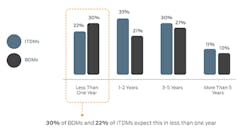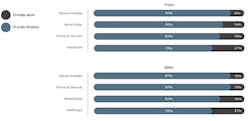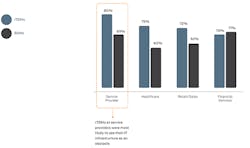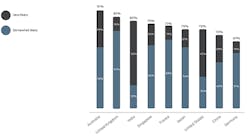Latest from Network Transformation/Edge Compute/IoT/URLLC/Automation/M2M
Will Your Company Survive?
Research Shows 3 Challenges Ahead
Business is changing fast. Even companies that believe they have a competitive edge today are at risk of falling behind. Information Technology (IT) keeps businesses booming, but it’s a stretch for busy executives to drop into the data center to ensure that server racks and network boxes are humming. Leadership is preoccupied with growing the customer base, keeping costs down, profitability, and growth. At a time when disruptive products and services are the name of the game, it’s become clear that doing "enough" with your technology investment simply isn’t enough to survive.
A global study of 1,800 IT decision-makers (ITDMs) and 904 business decision-makers (BDMs) found that 2 problems are stalling business transformation. To remain relevant in the future, companies need to address impending disruption by rethinking their approach to IT for ongoing innovation.
New data from Wakefield Research, sponsored by Juniper Networks, has revealed the roadblocks that keep companies from innovating for today’s — and more importantly, tomorrow’s — business climate. This report calls out some startling statistics and findings for companies trying to stay competitive, including:
1. IT and the C-Suite Disconnects
2. Talent Gap
3. Outdated IT Infrastructure
Throughout the study findings, a common business theme emerges. Key decision-makers in surveyed organizations recognize the value of C-Suite engagement in technology decisions, and that the network is at the heart of business transformation. The global results are overwhelming in commonality.
Perceptions
Companies believe they have a competitive advantage today. With the right technology investments, businesses today can stay ahead of the game. A high percentage of respondents say their company’s primary products and services have a competitive advantage over their competitors. But business is changing fast. Being ahead today does not guarantee staying on top in the future. BDMs and ITDMs expect their industries will soon be disrupted. The majority of BDMs and ITDMs anticipate a new disruptive technology, product or service to be introduced into their industry in 2 years or less. (See Figure 1.)
Figure 1. Percentage of respondents that expect a new disruptive technology, product or service to be introduced into their industry.
Companies may not be able to adapt quickly enough for today’s pace of change. In fact, BDMs and ITDMs say it would take at least 1 year to keep up if a competitor offered a drastically superior product or service. True innovation requires an understanding of the value that technology brings and enables. The C-Suite doesn’t need to code, but leading a company strategy for growth requires a strong relationship between those who set the strategy and those who execute.
In today’s business environment, strong technical skills and know-how are essential for strategic decision-making. This expertise is key to getting the most out of IT and enabling your technology to be ready for today’s disruptions and tomorrow’s success.
Yet many organizations lack this knowledge at the highest levels, hamstrung by a C-Suite that isn’t tech-savvy. A market advantage isn’t likely to last unless leadership stays at the forefront of innovation.
Obstacle 1
IT and the C-Suite Disconnects
The vast majority of ITDMs and BDMs agree that their company would perform better if the C-Suite were more tech-savvy. Decision-makers view the C-Suite’s lack of tech-savvy as holding the company back. And nearly 9 in 10 IT and business decision-makers admit their organization would perform better if their current C-Suite were more tech-savvy.
Across industries, survey participants recognized a missed opportunity. With the need for businesses to stay ahead of the pace of change, respondents expressed a desire for tech-savvy leadership.
Technical respondents clarified further, asserting that executive leadership could gain greater benefits and value from their network investments. The C-Suite is out of touch with IT — and they don’t see the network as key to their company’s success. In fact, 7 out of 10 IT decision-makers agree that the C-Suite doesn’t view the network as vital to company success. (See Figure 2.)
Figure 2. Percentage of respondents that agree with the following statement: "Our company would perform better if the C-Suite were more tech-savvy".
Only thinking about IT for today will hamper tomorrow’s success. Innovation is a must for companies wanting to stay ahead in today’s constantly disruptive landscape. But a lack of investment in IT, the group at the heart of making it all happen, is proving to be a barrier, and is preventing the business from keeping up with the pace of change to stay competitive. The research found that IT roadblocks are troublesome to the core of any business.
Obstacle 2
The Talent Gap
IT staff are challenged with keeping up with companies’ growing needs. More than 2 in 5 ITDMs and BDMs think that 25% or more of their company’s IT workforce will not have the skills they’ll need for their role 5 years from now.
And from an industry view, the statistic is even more alarming, with some respondents expressing concern that over half their workforce won’t have the required skills. (See Figure 3.)
Figure 3. Percentage of respondents that believe half or more of their company’s IT workforce will not have the skills that they need in their role 5 years from now.
Obstacle 3
Outdated IT Infrastructure
Across all industries, IT infrastructure is holding companies back.
ITDMs and BDMs believe their company’s current IT infrastructure presents an obstacle to introducing new products and services. From siloed databases to high-cost roll-outs for service providers, legacy infrastructure can hurt and hinder business growth.
The vast majority of respondents say it’s likely their IT infrastructure would be an obstacle to accelerating a new product or service. (See Figure 4.)
Figure 4. Percentage of respondents that find it "somewhat" or "very likely" their company’s IT infrastructure would be an obstacle to accelerating a new product or service.
And why isn’t legacy technology upgraded with the needs of the business? A common challenge that most companies face: the cost of innovation. Both BDMs and ITDMs see budget as the primary obstacle to upgrading their company’s IT infrastructure, preventing them from keeping up with change.
Endnote
This information is excerpted from the June 2016 research report Will Your Company Survive the Next Big Disruption? IT As The Great Enabler by Juniper Networks. This study was conducted with independent global research firm Wakefield Research, with 20 content questions, 2,704 respondents, in 8 countries. For more information about this report, please visit http://www.juniper.net/assets/us/en/local/pdf/executive-briefs/7400035-en.pdf.









